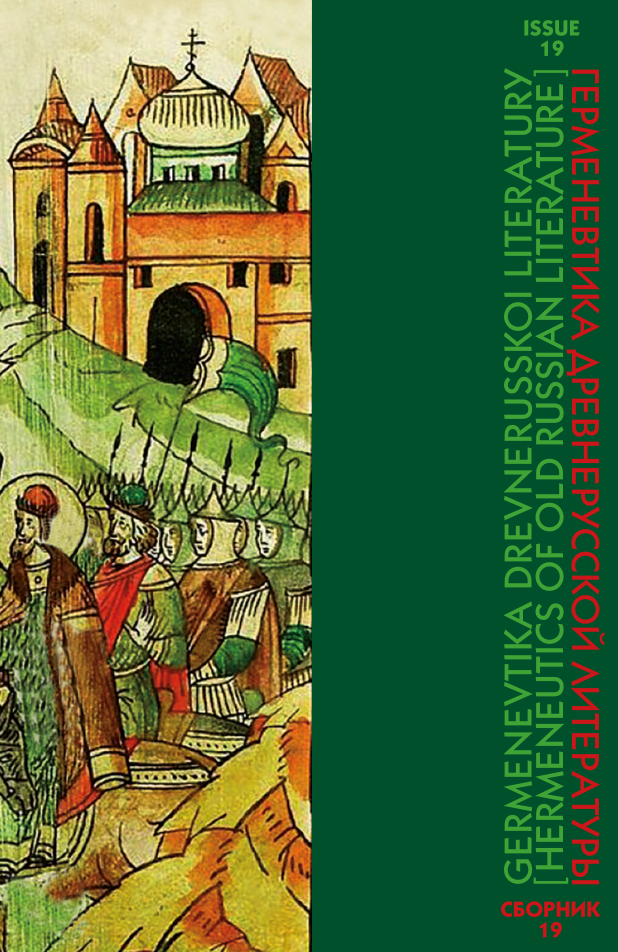Acknowledgements:
The article was completed with the support of the Russian Science Foundation, project No. 22-18-00005.
Abstract:
The article examines the poetics of the Life of St. John Climacus according to the Chetya-Menaion of St. Dimitry of Rostov published in the Kyiv Pechersk Lavra in 1746. The key motif of the ladder, its semantic and poetic functions in the Life are considered. The analysis is carried out in comparison with the text of the Life of the first printed edition of the Ladder of 1647. While compiling the Life, Saint Dimitry of Rostov turned to various sources — Greek, Slavonic and Latin, and also to two source texts for him, namely, the brief Life of John of Sinai, compiled by Daniel of Raifa and the hagiographic narrative of a certain monk “synchronous,” contemporary of the saint. Preserving the meaning of the ladder topos from the brief Life with its main idea of ascent from the world of the “material” to the “spiritual” world, St. Dimitry of Rostov structures the Life according to the “bios” type, following the chronology, for this purpose he makes insertions from the “synchronous’s” text. He also includes his own explanatory and clarifying remarks in the text, indicates the authorship of the texts he uses, which proves conscious quotation, separating his own text from the other authors’. The general conclusion of the article is the affirmation of the change of writer’s type, new interaction of the writer-hagiographer with the text, which is characteristic of the transitional epoch of the 17th – 18th centuries, as well as the changes in the narrative, a freer and more creative attitude to the writer’s work, striving for rationalization and at the same time strict adherence to the hagiographic canon.
REFERENCES
1 Aleksandr Derzhavin, prot. “Chetii-Minei Dimitriia, mitropolita Rostovskogo, kak tserkovno-istoricheskii i literaturnyi pamiatnik” [“Chetya-Menaion of St. Dimitry, Metropolitan of Rostov, as a Church-Historical and Literary Monument”]. Bogoslovskie trudy, part 2, no. 16, 1976, pp. 46–141. (In Russian)
2 Dorofeeva, L.G. “Agiograficheskaia topika v zhitii Ioanna Sinaiskogo (na materiale staropechatnogo izdaniia Lestvitsy 1647 G.)” [“Hagiographic Topic in the Life (Vita) of John of Sinai (on the Material of the Old Printed Edition of the Ladder of 1647)”]. Novyi filologicheskii vestnik, no. 3 (62), 2022, pp. 106–124. (In Russian)
3 Dorofeeva, L.G. “Topos lestvitsy v zhitii Ioanna Sinayskogo (na materiale Optinskogo perevoda lestvitsy)” [“Topos of Ladder in the Life (Vita) of John the Sinai (Based on the Optina Translation of the ‘Ladder’)”]. Germenevtika drevnerusskoi literatury [Hermeneutics of Old Russian Literature]. Issue 22. Ed.-in-chief O.A. Tufanova. Moscow, IWL RAS Publ., 2023, pp. 312–328. https://doi.org/10.22455/HORL.1607-6192-2023-22-312-328 (In Russian)
4 Kruming, A.A. “Chet’i Minei sviatogo Dimitriia Rostovskogo. Ocherk istorii izdaniia” [“Chetya-Menaion of St. Dimitry of Rostov. An Overview of the History of its Publication”]. Filevskie chteniia, no. 9: Sviatoi Dimitrii, mitropolit Rostovskii: Issledovaniia i materialy [ Filev’s Readings, no. 9: St. Dimitry, Metropolitan of Rostov: Research and Materials], ed. L.A. Iankovskaya. Moscow, Soratnik Publ., 1994, pp. 5–52. (In Russian)
5 Lepakhin, V.V. Ikona i ikonichnost’ [Icon and Iconicity]. 2nd ed. rev. and comp. St. Petersburg, Uspenskoe podvor’e Optinoi Pustyni Publ., 2002. 400 p. (In Russian)
6 Likhachev, D.S. “V chem sut’ razlichii mezhdu drevnei i novoi russkoi literaturoi” [“What Are the Differences between Old and Modern Russian Literature?”]. Voprosy literatury, no. 5, 1965, pp. 170–186. (In Russian)
7 Panchenko, A.M. “Perekhod ot drevnei russkoi literatury k novoi” [“Transition from Old Russian Literature to Modern One”]. Panchenko, А.М. Russkaia istoriia i kul’tura, raboty raznykh let [ Russian History and Culture: Works of Various Years]. St. Petersburg, Iuna Publ., 1999, pp. 297–318. (In Russian)
8 Popova, T.G. “Obraz ognya v Lestvitse Ioanna Sinayskogo” [“Image of Fire in the ‘Ladder’ of John Climacus”]. Germenevtika drevnerusskoi literatury [Hermeneutics of Old Russian Literature]. Issue 22. Ed.-in-chief O.A. Tufanova. Moscow, IWL RAS Publ., 2023, pp. 292–311. https://doi.org/10.22455/HORL.1607-6192-2023- 22-292-311 (In Russian)
9 Sapozhnikova, O.S. Russkii knizhnik XVII v. Sergey Shelonin. Redaktorskaya deyatel’nost’ [ Russian Writer of the 17th Century Sergey Shelonin. Editorial Activity]. Moscow, St. Petersburg, “Alliance-Archeo” Publ., 2010. 560 p. (In Russian)
10 Uzhankov, A.N. Istoricheskaia poetika drevnerusskoi slovesnosti. Genezis literaturnykh formatsii. Monografiia [Historical Poetics of Old Russian Literature. The Genesis of Literary Formations. Monograph]. Moscow, Literaturnyi institut im. A.M. Gor’kogo Publ., 2011. 512 p. (In Russian)
11 Fedotova, M.A. “K istorii Chet’ikh Minei Dimitriia Rostovskogo: rukopisnye materialy” [“On the History of Chetya-Menaion of Dimitry of Rostov: Manuscript Materials”]. Vestnik Novosibirskogo Gosudarstvennogo Universiteta. Series: History, Philology, vol. 11, no. 12, 2012, pp. 123–133. (In Russian)






